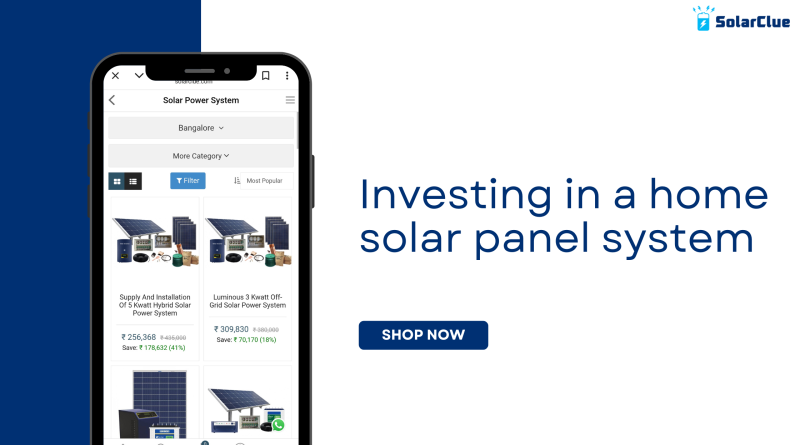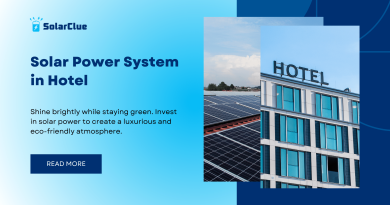Investing in a home solar panel system
In today’s era of increasing emphasis on sustainable energy solutions, solar power is a leading contender for fostering a greener future. Within India, the demand for home solar panel systems continues to surge, fueled by environmental consciousness and the aspiration for energy independence. One pivotal aspect that homeowners carefully consider before embracing solar energy is the installation cost. In this detailed guide, we delve into the myriad factors influencing the solar system price dynamics of setting up a home solar panel system in 2024.
Grasping the Fundamentals of Home Solar Panel Systems:
Before delving into cost considerations, it’s essential to grasp the foundational components of a home solar panel system. A typical setup comprises solar panels, inverters, mounting structures, wiring, and, optionally, batteries for energy storage. The number of solar panels and the inverter’s capacity hinge on household energy requirements and available rooftop space.
Factors Impacting Home Solar Panel System Installation Costs:
Solar Panel Efficiency and Type: The efficiency and type of solar panels play a significant role in determining overall costs. Although pricier, high-efficiency panels offer more significant electricity generation within a limited space. Monocrystalline panels, renowned for their efficiency, typically command a higher price than polycrystalline or thin-film options.
System Capacity: The size of the solar power system required correlates directly with household energy consumption. Larger systems with greater capacities naturally entail higher upfront costs. Conducting a thorough energy audit aids in pinpointing the optimal system size tailored to individual home needs.
Inverter Type: The choice between string inverters and microinverters influences overall costs. While string inverters are more cost-effective, microinverters offer enhanced performance, particularly in shaded environments.
Mounting Structures and Installation Complexity: The type of mounting structure and installation intricacies significantly impact costs. Ground-mounted systems, necessitating additional materials and labor, generally incur higher expenses than rooftop installations. Moreover, installations on complex roof designs may entail extra costs.
Quality of Components: The quality of solar panels, inverters, batteries, and other system components directly affects performance and longevity. Opting for high-quality equipment may elevate initial costs, but promises improved efficiency and durability over the system’s lifespan.
Government Subsidies and Incentives: Various government schemes influence solar system price at both state and central levels offer subsidies and incentives to promote solar adoption in India. These incentives substantially offset installation costs, making solar power more accessible to a broader demographic.
Installation Charges: Installation charges encompass labor, equipment, and ancillary expenses. Entrusting the installation to a reputable and experienced provider ensures a seamless process and minimizes the risk of issues that could lead to additional expenses.
Average Solar Panel Installation Cost in India, 2024:
The average installation cost of a home solar panel system in India ranges widely from INR 1.5 lakh to over INR 5 lakh. Here’s a breakdown of the expenses for different system sizes:
| System Size | Cost |
| 1 kW Solar Power System | Rs. 90,000 – 1,20,000 |
| 2 kW Solar Power System | Rs. 1,10,000 – Rs. 1,25,000 |
| 3 kW Solar Power System | Rs. 1,70,000 – Rs. 2,00,000 |
| 4 kW Solar Power System | Rs. 2,10,000 – Rs. 2,50,000 |
| 5 kW Solar Power System | Rs. 2,50,000 – Rs. 3,00,000 |
| 6 kW Solar Power System | Rs. 3,00,000 – Rs. 3,30,000 |
| 7 kW Solar Power System | Rs. 3,30,000 – Rs. 3,80,000 |
| 8 kW Solar Power System | Rs. 4,00,000 – Rs. 4,20,000 |
| 9 kW Solar Power System | Rs. 4,10,000- Rs. 4,30,000 |
Conclusion:
Investing in a home solar panel system in India in 2024 entails a multifaceted decision-making process encompassing various factors such as component types, system capacity, and installation intricacies. While the initial costs may seem substantial, it’s imperative to consider the long-term benefits.
This comprehensive exploration of solar system installation costs underscores the economic viability of scaling up solar capacity. If you have further inquiries or insights, we encourage you to share your thoughts in the comments below.


